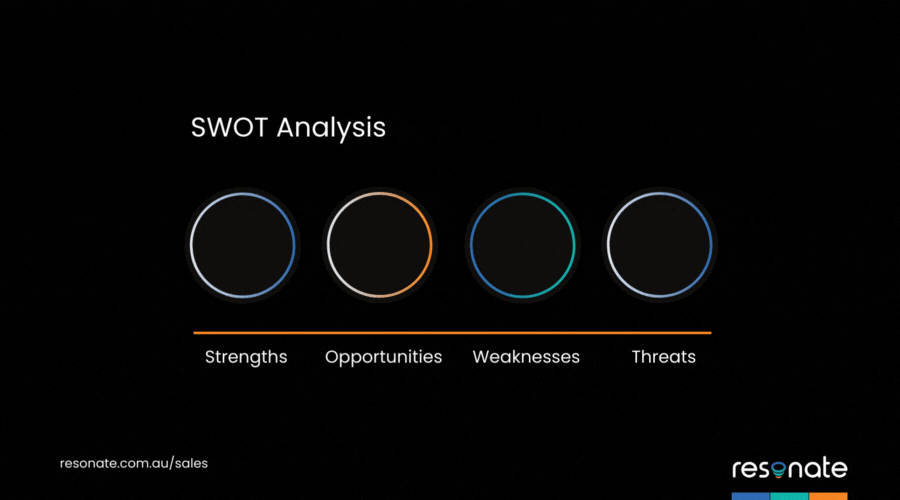When sports teams train and prepare for a match, they study their competition. Without an understanding of how their competition plays, works as a team and gets outcomes, a sports team will walk onto the field partially unprepared and their chances of losing the match increase.
A company that does not understand its competition stands to experience the same chance of losing out. In business strategy, competitive analysis enables you to understand what makes your business unique and provides guidance on what you can improve. In marketing, you can try your competitors’ tactics on your audience and find new cut-throughs. In sales, too, competitive analysis provides an opportunity to better understand the market and deliver value in conversations with prospects and customers.

How to identify your competition
You can divide your competition into two categories: direct and indirect.
Direct competition includes organisations offering similar products and likely operating in the same geographical area. For example, Australian companies are unlikely to engage with a managed IT provider based in the USA. Identifying and understanding your direct competitors must be your primary focus.
Indirect competitors do not offer the same products or services as you, but they might solve the same customer problems. They might also demonstrate the potential to shift into your market or develop a similar product. While they are not a direct threat, you should monitor them.
The key facts you must know about your competition
To use competitor analysis when winning deals, you will need to understand some key facts:
Features of products and services: Analyse your competitor’s entire product or service line and the quality of their offerings. Determine their market share and identify what makes their products or services unique within the B2B sector.
Pricing model: Assess competitors’ pricing structures and compare their offerings to yours. For example, if they have lower prices, analyse what they deliver. They might be cheaper, but they may not offer as many capabilities.
Market share and presence: Investigate competitors’ growth, yearly revenue, and sales volume to understand their market share. Gathering this information may be challenging, especially for privately held companies.
Customer perception and satisfaction: Collect data from professional reviews, testimonials, and industry forums to gauge customer satisfaction and experiences with competitors’ products.
Sales strategy: Identify how competitors approach selling and winning business. Understand their sales channels, customer engagement strategy, how they close deals and even the CRM they use. You might not be able to find all of this information publicly, so I recommend reaching out to your network in these cases.
Marketing tactics: Understand how competitors promote their products across marketing channels. Observe the engagement on their social media and note if they use email marketing for product promotions. Review their blog content to understand how they approach thought leadership. It is also a good idea to check for resources such as product or buying guides that support the sales cycle.

How do you find these key facts?
Competitive analysis includes reviewing industry reports, the companies’ online presence and contacting your network. Use the following techniques to quickly find information about your competitors:
Follow marketing channels: Follow your competitors on social media, subscribe to their newsletters, bookmark their websites and regularly check their blogs. These actions will ensure you stay updated with organisational changes and new offerings.
Speak to your customers and prospects: Your customers and prospects could have invaluable insights about your competition, especially if they have previously used their products or services. For example, if a customer moves to your competitors, inquire about their reasons for shifting. Conversely, if a prospect chooses your business, ask about the issues they faced with their previous supplier. Their experiences can offer valuable insights into competitors’ sales tactics and pricing strategies.
Speak to your network: Not all the information you need will be publicly available. In these cases, leverage your professional network to gather information. While people will unlikely share detailed information about the business strategy, your network might share insights about your competitor’s growth and success with certain products or services.
Conduct a SWOT analysis: A SWOT analysis assesses your competitors’ strengths, weaknesses, opportunities, and threats. This analysis will illuminate what they do well, where they fall short, any activities that threaten your business and the opportunities they have capitalised on.

How this information drives the sales process
The insights gained from competitive analysis greatly inform your sales strategy. When you show an understanding of your competitor’s products and their business, you will appear as a trusted advisor who understands the market.
It also makes clear the points that make your business stand out. By understanding the strengths and weaknesses of competitors, you can steer your conversations toward what your business does well and how you address gaps in the market.
If a prospect compares you with a competitor, you will have the insight to counteract their point with something that makes your business different. Of course, you should not slander the competition but politely point out where their offering might not suit your prospect.

Conclusion
Like a well-prepared team can turn the tide of a sports game, a sales team with knowledge of their competitors can confidently navigate the market and win deals.
Understanding your competition gives you an advantage during the sales cycle. Analysing product features, pricing, market presence, customer perception, sales strategy, and marketing tactics informs a strong sales approach. Following your competitors’ marketing channels, speaking with your customers and network and conducting a SWOT analysis enable you to collect this data.
When you know and follow your direct and indirect competitors, you better understand your business’ unique offering. You also position yourself as a knowledgeable consultant during the sales cycle that can highlight your business’ unique offerings and address market gaps to differentiate what makes you competitive.
Why choose Resonate to guide your sales strategy?
One of our specialities is enabling B2B sales organisations to launch go-to-market strategies for high-value products. We work closely with sales leaders to define the sales strategy, including competitive analysis, and convert that into execution that delivers predictable revenue. Through ongoing advisory and consulting services, we help refine your unique value proposition so your business stands out in the market.
Visit our Sales Services page for more information on how we can support your organisation.
Related blogs
7 key steps for crafting your competitive strategy




